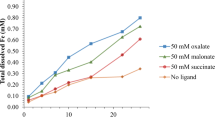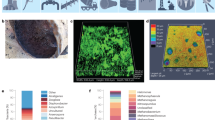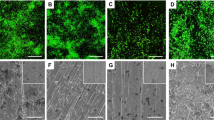Abstract
Corrosion of iron presents a serious economic problem. Whereas aerobic corrosion is a chemical process1, anaerobic corrosion is frequently linked to the activity of sulphate-reducing bacteria (SRB)2,3,4,5,6. SRB are supposed to act upon iron primarily by produced hydrogen sulphide as a corrosive agent3,5,7 and by consumption of ‘cathodic hydrogen’ formed on iron in contact with water2,3,4,5,6,8. Among SRB, Desulfovibrio species—with their capacity to consume hydrogen effectively—are conventionally regarded as the main culprits of anaerobic corrosion2,3,4,5,6,8,9,10; however, the underlying mechanisms are complex and insufficiently understood. Here we describe novel marine, corrosive types of SRB obtained via an isolation approach with metallic iron as the only electron donor. In particular, a Desulfobacterium-like isolate reduced sulphate with metallic iron much faster than conventional hydrogen-scavenging Desulfovibrio species, suggesting that the novel surface-attached cell type obtained electrons from metallic iron in a more direct manner than via free hydrogen. Similarly, a newly isolated Methanobacterium-like archaeon produced methane with iron faster than do known hydrogen-using methanogens, again suggesting a more direct access to electrons from iron than via hydrogen consumption.
This is a preview of subscription content, access via your institution
Access options
Subscribe to this journal
Receive 51 print issues and online access
$199.00 per year
only $3.90 per issue
Buy this article
- Purchase on Springer Link
- Instant access to full article PDF
Prices may be subject to local taxes which are calculated during checkout



Similar content being viewed by others
References
Uhlig, H. H. Corrosion and Corrosion Control 3rd edn (Wiley, New York, 1985)
Hamilton, W. A. Microbially influenced corrosion as a model system for the study of metal microbe interactions: a unifying electron transfer hypothesis. Biofouling 19, 65–76 (2003)
Lee, W., Lewandowski, Z., Nielsen, P. H. & Hamilton, W. A. Role of sulfate-reducing bacteria in corrosion of mild steel: a review. Biofouling 8, 165–194 (1995)
Pankhania, I. P. Hydrogen metabolism in sulphate-reducing bacteria and its role in anaerobic corrosion. Biofouling 1, 27–47 (1988)
Widdel, F. in Biotechnology Focus 3 (eds Finn, R. K. et al.) 277–318 (Hanser, Munich, 1992)
Cord-Ruwisch, R. in Environmental Microbe-Metal Interaction (ed. Lovley, D. R.) 159–173 (ASM Press, Washington, DC, 2000)
Costello, J. A. Cathodic depolarization by sulphate-reducing bacteria. S. Afr. J. Sci. 70, 202–204 (1974)
von Wolzogen Kuehr, C. A. H. & van der Vlugt, I. S. The graphitization of cast iron as an electrobiochemical process in anaerobic soil. Water 18, 147–165 (1934)
Booth, G. H. & Tiller, A. K. Cathodic characteristic of mild steel in suspension of sulphate-reducing bacteria. Corros. Sci. 8, 583–600 (1968)
Pankhania, I. P., Moosavi, A. N. & Hamilton, W. A. Utilization of cathodic hydrogen by Desullfovibrio vulgaris (Hildenborough). J. Gen. Microbiol. 132, 3357–3365 (1986)
Iverson, W. P. & Olson, G. J. in Current Perspectives in Microbial Ecology (eds Klug, M. J. & Reddy, C. A.) 623–627 (ASM, Washington, DC, 1984)
Bockris, J. O'M. & Reddy, A. K. N. Modern Electrochemistry Vol. 2 (Plenum, New York, 1970)
Beech, I. B. et al. Study of parameters implicated in the biodeterioration of mild steel in the presence of different species of sulphate-reducing bacteria. Int. Biodeter. Biodegrad. 34, 289–303 (1994)
Rabus, R., Hansen, T. & Widdel, F. in The Prokaryotes: An Evolving Electronic Resource for the Microbiological Community (eds Dworkin, M., Falkow, S., Rosenberg, E., Schleifer, K.-H. & Stackebrandt, E.) (Springer, New York, 2000)
Widdel, F. & Bak, F. in The Prokaryotes 2nd edn Vol. 6 (eds Balows, A., Trüper, H. G., Dworkin, M., Harder, W. & Schleifer, K.-H.) 3352–3378 (Springer, New York, 1992)
Hardy, J. A. Utilisation of cathodic hydrogen by sulphate-reducing bacteria. Br. Corros. J. 18, 190–193 (1983)
Laishley, E. J. & Bryant, R. D. in Biochemistry and Physiology of Anaerobic Bacteria (eds Ljungdahl, L. G., Adams, M. W., Barton, L. L., Ferry, J. G. & Johnson, M. K.) 252–260 (Springer, New York, 2003)
Cord-Ruwisch, R. & Widdel, F. Corroding iron as a hydrogen source for sulphate reduction in growing cultures of sulphate-reducing bacteria. Appl. Microbiol. Biotechnol. 25, 169–174 (1986)
Daniels, L., Belay, N., Rajagopal, B. S. & Weimer, P. J. Bacterial methanogenesis and growth from CO2 with elemental iron as the sole source of electrons. Science 237, 509–511 (1987)
Deckena, S. & Blotevogel, K.-H. Fe0-oxidation in the presence of methanogenic and sulphate-reducing bacteria and its possible role in anaerobic corrosion. Biofouling 5, 287–293 (1992)
Schlegel, H. G. General Microbiology 7th edn (Cambridge Univ. Press, Cambridge, 1993)
Manz, W., Eisenbrecher, M., Neu, T. R. & Szewzyk, U. Abundance and spatial organization of Gram-negative sulfate-reducing bacteria in activated sludge investigated by in situ probing with specific 16S rRNA targeted oligonucleotides. FEMS Microbiol. Ecol. 25, 43–61 (1998)
Appia-Ayme, C., Guiliani, N., Ratouchniak, J. & Bonnefoy, V. Characterization of an operon encoding two c-type cytochromes, an aa3-type cytochrome oxidase, and rusticyanin in Thiobacillus ferrooxidans ATCC 33020. Appl. Environ. Microbiol. 65, 4781–4787 (1999)
Bond, D. R. & Lovley, D. R. Electricity production by Geobacter sulfurreducens attached to electrodes. Appl. Environ. Microbiol. 69, 1548–1555 (2003)
Deppenmeier, U. The unique biochemistry of methanogenesis. Prog. Nucleic Acid Res. Mol. Biol. 71, 223–283 (2002)
Muyzer, G., Teske, A., Wirsen, C. O. & Jannasch, H. W. Phylogenetic relationships of Thiomicrospira species and their identification in deep-sea hydrothermal vent samples by denaturing gradient gel electrophoresis of 16S rDNA fragments. Arch. Microbiol. 164, 165–172 (1995)
Huber, H. et al. A new phylum of Archaea represented by a nanosized hyperthermophilic symbiont. Nature 417, 63–67 (2002)
Ludwig, W. et al. ARB: a software environment for sequence data. (Department of Microbiology, Technical Univ. Munich, 2002); available at 〈http://www.arb-home.de/〉.
Pernthaler, A., Pernthaler, J. & Amann, R. Fluorescence in situ hybridization and catalyzed reporter deposition for the identification of marine bacteria. Appl. Environ. Microbiol. 68, 3094–3101 (2002)
Acknowledgements
We thank K. Nauhaus, M. Nellesen and G. Herz for technical help. This study was supported by the German Academic Exchange Service, the Fonds der Chemischen Industrie, and the Max Planck Society.
Author information
Authors and Affiliations
Corresponding author
Ethics declarations
Competing interests
The authors declare that they have no competing financial interests.
Supplementary information
Supplementary Information
This contains remarks on corrosion reactions, and additional figures. (PDF 313 kb)
Rights and permissions
About this article
Cite this article
Dinh, H., Kuever, J., Mußmann, M. et al. Iron corrosion by novel anaerobic microorganisms. Nature 427, 829–832 (2004). https://doi.org/10.1038/nature02321
Received:
Accepted:
Issue Date:
DOI: https://doi.org/10.1038/nature02321
This article is cited by
-
Microbiologically Influenced Corrosion in Stainless Steel by Pseudomonas aeruginosa: An Overview
Journal of Bio- and Tribo-Corrosion (2024)
-
Mitigation of Desulfovibrio ferrophilus IS5 degradation of X80 carbon steel mechanical properties using a green biocide
Biodegradation (2024)
-
Removal of nitrosamine–hexavalent chromium pollution through coupling immobilization of power activated carbon, zero-valent iron, and degrading bacteria
International Journal of Environmental Science and Technology (2024)
-
A corrosion-resistant RuMoNi catalyst for efficient and long-lasting seawater oxidation and anion exchange membrane electrolyzer
Nature Communications (2023)
-
Double emulsions as a high-throughput enrichment and isolation platform for slower-growing microbes
ISME Communications (2023)
Comments
By submitting a comment you agree to abide by our Terms and Community Guidelines. If you find something abusive or that does not comply with our terms or guidelines please flag it as inappropriate.



